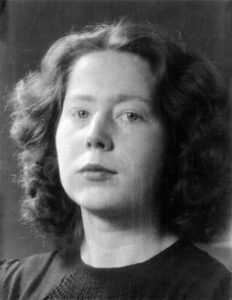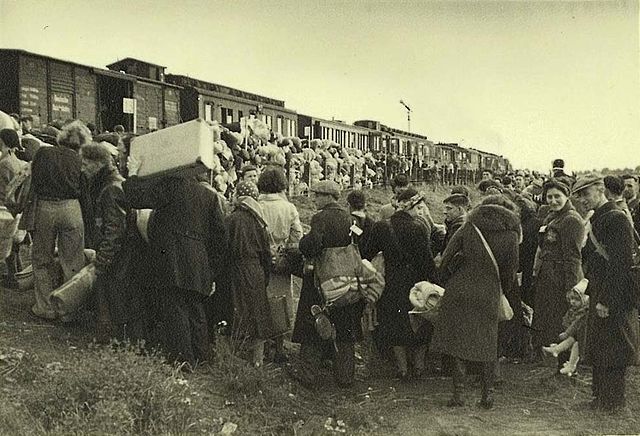
Standing up to Fascism (North Holland, mostly Amsterdam and Haarlem, the Netherlands; 1940 — 1945): They say people break. She never did.
“How does evil spread?” asked the literary voice narrating this forgotten story of a heroic non-Jewish Dutch Resistance fighter, ignited when the Nazis took over the Netherlands in 1940. She admired people “who stand up for their beliefs, because the world is currently drunk on war.”

National Archief [Public domain]
via Wikimedia Commons
She left so little documentation behind to protect those she loved, collaborated with, and for the mission. Award-winning historian Buzzy Jackson turned to historical fiction to dig up as much as she could and imagine the rest to craft the breathtaking To Die Beautiful. Had Jackson not visited Amsterdam’s Dutch Resistance Museum, historical fiction readers most likely would still not even know her name: Jannetje Johanna Schaft before the invasion, transformed into Hannie Schaft afterwards. Later becoming known as The Girl with Red Hair (the title of the UK edition).
Jackson makes the unbelievable believable. You’ll be caught up in a whirlwind of emotions, thoughts, and heart-stopping suspense reading this electrifying novel. Anne Frank, the “most famous victim of the Dutch Holocaust,” looms heavy. Her diary left an accounting. Hannie left no such thing.
You may be asking, like Jackson did, why one of the few female WWII Dutch resisters is unknown to most of us considering more Dutch Jews perished in the Holocaust than in any other European country: 75%! Jackson notes and explains in her brief “Historical Notes,” suggestive of how deeply immersed she was in telling this story from the viewpoint of humanity. To Die Beautiful is historically based, but it’s an emotionally-driven powerhouse.
Capturing the segregation, fear, humiliation, rage, grief, loss, hunger, separations, and disappearances of those who were subjected to, witnessed, and lived through five traumatizing years of the Dutch Holocaust when Jews and their families were persecuted, rounded up, arrested, tortured, murdered, The Nazis adopted a scorched earth regime that also included non-Jews perceived as “Jew-lovers,” and ordinary Dutch citizens starved, looking as if they too had been forced into concentration camps most shockingly during the “Hunger Winter” (The Dutch Famine). Warning: the brief video below may be too disturbing to watch:
Jackson has put on a seasoned novelist’s hat, using charged prose grounded in historical realities: real people, places, events, timelines, atrocities, resistance operations. Glued to the 400+ pages, you’ll read at a faster clip than a novel half its size.
To Die Beautiful is a harrowing reminder of what tyranny looks like.
Agonizing to see what happens to Hannie, but we’re also in awe of what she does. Awe at how far someone is willing to go to protect two Jewish friends and save the lives of countless other Jews for the highest-minded of causes – to save humanity. Despite violent sabotage assignments to thwart the Nazi’s Operation Silver Fir that killed Dutch resistors and up-close Nazi assassinations that put the reader tensely into death-defying scenes, the Resistance’s refrain was: “Stay Human.” The novel a fierce reminder of what the bravest of souls can do with steely determination and still find a way to show their humanity when innocents came in harm’s way. A stark depiction of the lowest bar of humankind and the pinnacle of the highest.
Johanna Schaft wasn’t born with an “urge to resist.” Jackson shows us when that emotional force was kindled at age seven, with one of the many one-liners that grab our attention: “I wasn’t always an only child,” Hannie says on the opening line of Chapter 1. She became an only when her twelve-year-old sister Annie died thirteen years before the “sour tang of Nazism began to spread into every corner of daily life.” From the time she was a young girl to a twenty-year-old law student at the University of Amsterdam Johanna hits us again confiding she became “an expert at being nobody.”
Johanna kept to herself. Avoided being a trouble maker, she says was easy since she was “plain” and “shy.” (Not so plain with her “bright red hair”!) That all changed, she changed including her name, when she became best friends with two young Jewish women who were sister-like: Sonja and Philine. This came at a time when “nothing I was being taught about justice seemed to apply to the quickly changing world outside.” The evils of Nazism marked the birth of Hannie Schaft.
The novel calls up a stunning line in former Secretary of Defense Madeleine Albright’s book Fascism: A Warning: “If you pluck a chicken one feather at a time people don’t notice it” — until the chicken is stripped bare and it has taken hold of a nation. What a crushing, demoralizing defeat for the Netherlands proud of its centuries-old history. “The very reason refugees from fascism were drawn to the Netherlands was because we were known as much for our religious tolerance as for our windmills and wooden clogs.” And yet, in a mere five days the Nazis clobbered any notion of toleration.
The Nazis also waged a psychological war. They did everything to “chip away at the resources and morale of the enemy.” So too did the Dutch when the absence of a Dutch “military front” meant the “minds of the people became the front.” The significance of uplifting and sustaining morale in the Ukraine War cannot be overstated.
Hannie’s story includes four other resistance fighters. Two experienced men who trained and worked with her: Hendrik Oostdijk and Jan Bonekamp. Both feel real. Jan was, “willing to do things others wouldn’t do.” Hendrik is one of the few fictional characters, symbolic of the “brave Dutch men” who fought to save their citizens. Hannie’s relationship with Jan is a tender thread, deepening, stirring, and consequential. From there, she joins forces with two teenage girls, notably sisters: Truus and Freddie Oversteegen. A formidable Resistance trio. Non-fiction books and films have memorialized their legacy, but again Jackson provides a unique historical fictional focus.
So many Nazi acronyms will curdle your blood, the unleashing of their police, military, and intelligence arsenal. But the acronym to remember stands for the name of the Dutch Council of Resistance: RVV, for Raad Van Verzet.
The first one-liner that sticks with you and circles back is the opening sentence in the Prologue dated 1945 Amsterdam: “You can walk right past your fate your whole life without seeing it.” It does give a window to Hannie’s fate but not anywhere close to her destiny.
Hannie’s parents rightfully remembered too as they hid Sonja and Philine in the attic of their home in Haarlem no questions asked. We must never forget those who stood up to Fascism, informing us of how to react to political events today.
Anne Frank was hidden in an attic for two years. She died at sixteen in an infamous German concentration camp, Bergen-Belsen. The novel introduces a Dutch camp that began as a place for refugees, Westerbork, turned into a holding railway station for transporting Jews to concentration camps, far less familiar to us. It used to be the Dutch Theater. The Nazis desecrated it into a Holocaust site. Anne Frank went through there. “Not wanting to arouse the temper of the Dutch people,” Westerbork plucked this chicken slowly.

Rudolf Breslauer [Public domain] via Wikimedia Commons
Orange is the color of the Netherlands. Its meaning dates back to the country’s 16th century founder William I of Orange. The Dutch Resistance adopted it. Orange is the code for Courage.
Lorraine
Beautiful review, Lorraine, of what sounds like a deeply moving book. We went to the Museum of WW II Resistance in Amsterdam a few years ago. It was quite a powerful place in large part because there were so many everyday objects relating to life under the Occupation and to the nuts and bolts of managing a resistance network. I look forward, as ever, to the next Enchanted Prose. (Barton)
Hi Barton — Beautiful comment and reflections. Visited Amsterdam a few years ago too, but spent time at the Anne Frank House. Even seeing an international crowd waiting in such long lines was moving, and then feeling overcome imagining what was endured. To Die Beautiful gives you a sense of that with Hannie’s two sisters-in-heart and soul hidden in her parents Haarlem home. This book is outstanding. Thanks for reading and sharing. Lorraine